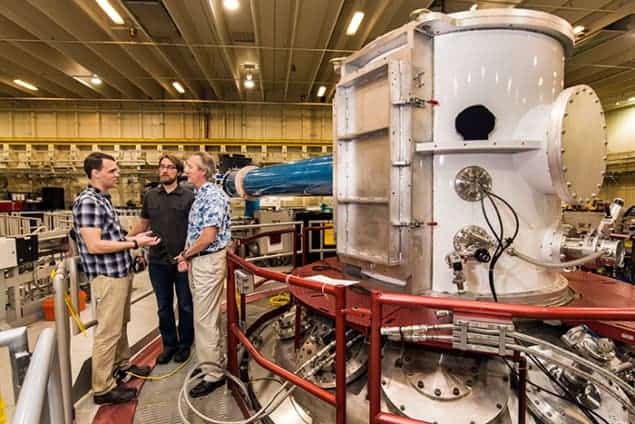
A new way to crush tiny amounts of matter in the hope of one day exploiting nuclear fusion for energy generation has been demonstrated by Matthew Gomez and colleagues at the Sandia National Laboratories in the US. The researchers used an enormous magnetic field produced by the lab’s Z Pulsed Power Facility (dubbed the”Z-machine”), together with a secondary field and a very brief laser pulse to implode a tube of deuterium fuel. This raised the fuel’s temperature to some 35 million degrees and produced lots of neutrons – a signature of fusion.
The technique is a new twist on inertial confinement, which uses extremely powerful laser beams to squeeze tiny capsules containing the hydrogen isotopes deuterium and tritium. This creates 100-million-degree “hotspots” in which the deuterium and tritium nuclei fuse, giving off large amounts of energy. This is the approach used by researchers at the $3.5bn National Ignition Facility (NIF) in the US, who have so far failed to achieve ignition. This is the point at which heat from fusion reactions causes more nuclei to fuse and more energy is given off by the target than is put in by the lasers.
Insulating magnetic field
To try to improve the implosions, some physicists have surrounded the target in an insulating magnetic field, with the aim of retaining more of the heat and particles produced by fusion. Three years ago, researchers using the OMEGA laser at the University of Rochester in the US used axial (cylindrical) fields to halve the amount of heat lost when imploding spherical targets. A spherical field cannot be used because it requires a conductor running through the target, which would contaminate the implosion.
In the latest research, Gomez and colleagues have used cylindrical targets, and instead of using a laser they have taken a new approach known as “magnetized linear inertial fusion” (MagLIF). This converts the Z-machine’s considerable electrical energy directly into kinetic energy. Deuterium is placed inside a cylindrical beryllium “liner” that is 7.5 mm tall and just less than 5 mm in diameter. Coils above and below the liner generate a 10 T axial magnetic field for a few thousandths of a second. This insulates the fuel while a 19 MA current pulse rips through the Z-machine and creates a 5000 T magnetic field that squeezes the liner and with it the fuel. The current pulse rises in 100 ns, and just before it reaches its peak, a much shorter pulse from a green laser is fired into the liner, pre-heating the fuel and raising its final temperature and pressure.
Hot neutrons
According to the team, this violent compression created “fusion-relevant conditions”: a temperature of about 35 million degrees and the production of about 1012 neutrons. These results imply an energy output of only about 1 J, but Gomez says that a deuterium–tritium fuel would produce around 300 J. The team also measured significant deuterium–tritium fusion, which is a by-product of the main deuterium–deuterium reactions. This, the researchers say, shows that the compression of the liner boosted the insulating magnetic field, making it better at confining tritium nuclei. “That is important,” Gomez says, “because as the target implosion progresses and the temperature goes up, you need a stronger magnetic field to confine the particles.”
Gomez’s colleague Steve Slutz outlined the MagLIF concept in 2010. He showed how the liner could be imploded at 70 km s–1 – much slower than NIF’s 300 km s–1 – and still produce temperatures and pressures high enough for fusion to occur. He calculated that with the Z-machine operating at its maximum of 27 MA and the liner filled with a deuterium–tritium mix, the fusion reaction would yield about the same energy as is delivered to the fuel – some 100 kJ.
Costly upgrade needed
Gomez acknowledges, however, that it will be some time before MagLIF enables ignition. He estimates that it will require a roughly 3000-fold increase in the current deuterium–tritium energy output – to around 1 MJ – which would entail at least doubling the Z-machine’s maximum current. That, he says, can only be done if the device is overhauled, at a cost of “hundreds of millions, if not a billion dollars” – a project that in the present economic climate he admits is “hard to sell”, and which, he says, is unlikely to switch on for at least a decade.
David Hammer, a plasma physicist at Cornell University in the US, who was not involved in the latest research, agrees that MagLIF is at an early stage. He estimates that another two years or more of experiments will be needed to test the feasibility of the concept, but nevertheless describes the initial results as “remarkably positive”. He points out that the pre-heating laser appears to have deposited less energy in the fuel than was expected, but believes that the insulating magnetic field is doing a pretty good job.
“This is the major physics success of these experiments,” he says, “and causes us all to be excited about follow-up experiments with better laser coupling.”
Two papers describing the experiment and the underlying theory will be published in a forthcoming issue of Physical Review Letters.



